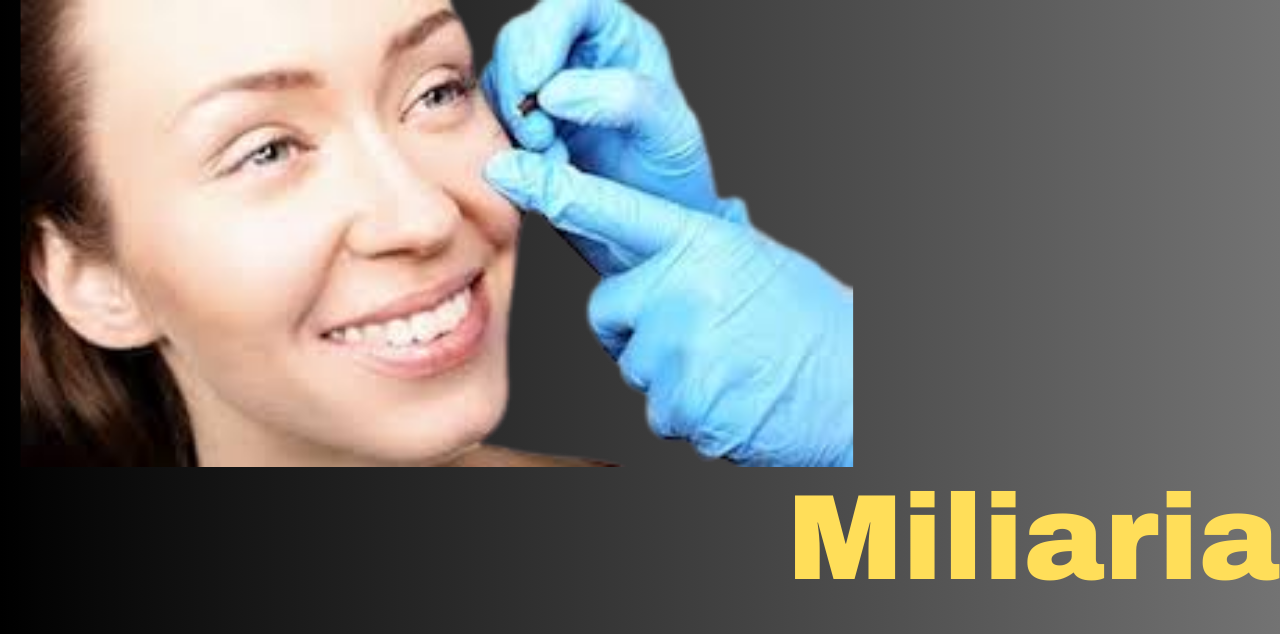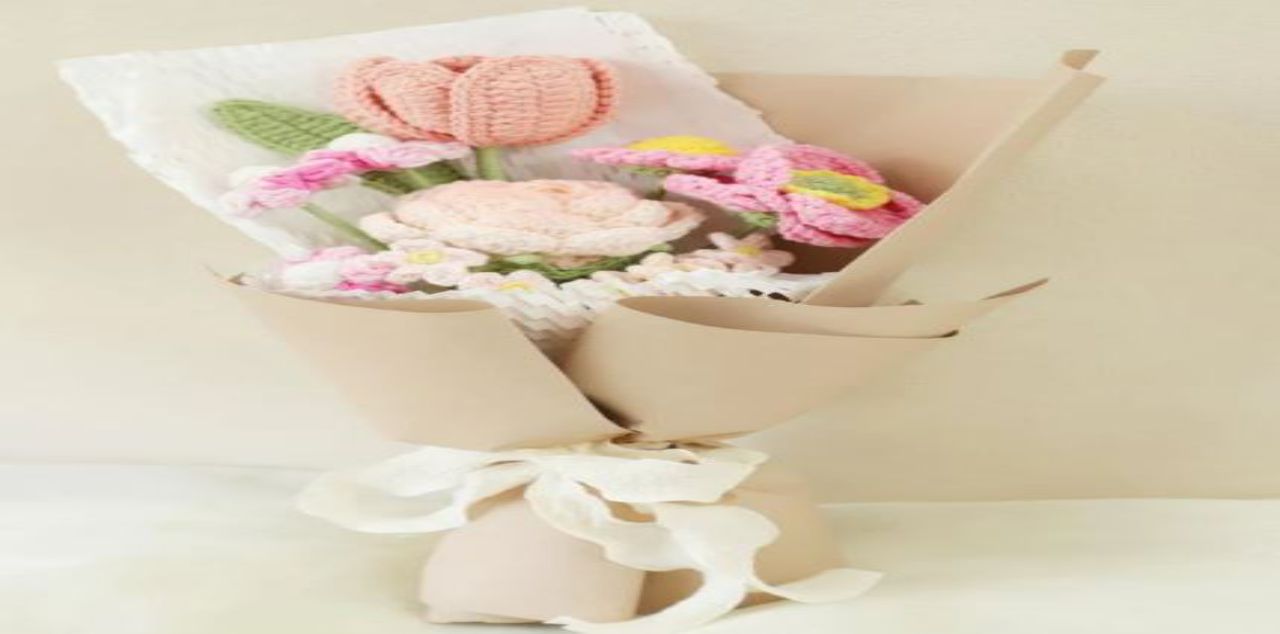milialar, despite their small size, can be a substantial issue for people who have them. Miliaria. These microscopic, pearl-like cysts form just beneath the skin’s surface and can affect anyone of any age or gender. Here’s a more in-depth look at milia, why they form, and how to control them. milialar
What exactly is Milia?
Milia are little white or yellowish cysts that typically develop around the nose, cheeks, and eyes, but can appear anywhere on the face. They are 1 to 2 millimeters in size and are loaded with keratin, a protein that is found in our skin, nails, and hair. milialar
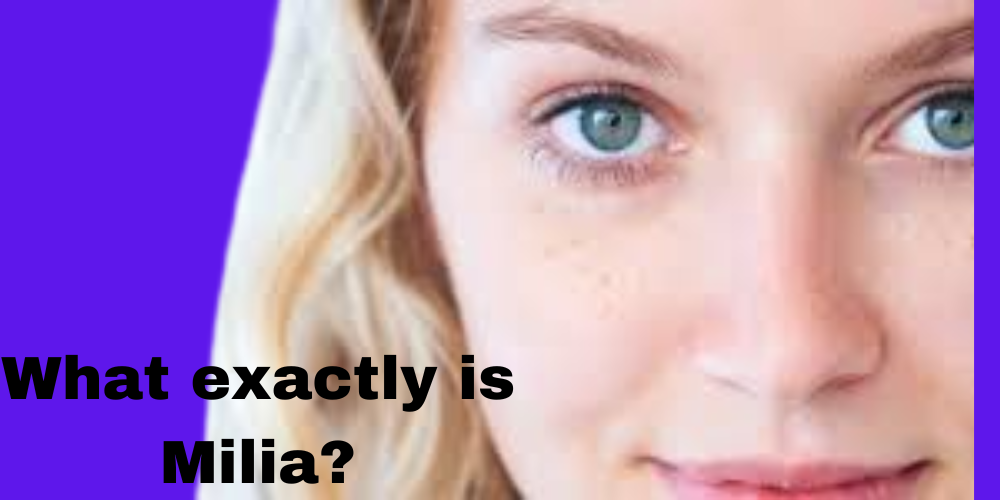
What Are the Causes of Milia?
Milia can be caused by a number of circumstances, including:
- Skin Renewal Process: Skin does not always exfoliate as it should. Milia can occur when dead skin cells become trapped beneath the skin’s surface. milialar
- Skin Impairment: Milia can be caused by sunburns, blistering injuries, or other types of skin trauma.
- Application of Heavy Creams or Oils: Thick skincare products can clog pores and cause milia to appear. Miliaria
- Certain Medical Conditions: Milia can be exacerbated by some hereditary abnormalities and skin problems.
Miliaria Types: Understanding the Differences
Miliaria, often known as prickly heat or sweat rash, is a skin ailment caused by clogged sweat glands. Sweat becomes trapped beneath the skin’s surface as a result of this blockage, resulting in the creation of tiny, irritating bumps. While miliaria is unpleasant, it is usually harmless and resolves on its own. Understanding the severity of the problem and the necessary therapies might be aided by understanding the various forms of miliaria. Here’s a breakdown of the different types:
Crystallina Miliaria
- Small, transparent, or white blisters packed with sweat appear. These blisters are superficial, forming on the skin’s uppermost layer.
- Causes: A blockage arises in the stratum corneum (the skin’s outermost layer).
- Symptoms: This variety is often painless and non-itchy.
- Treatment: It usually resolves on its own without any intervention.
Miliaria Rubra is a type of moss.
- Small, red pimples that are often prickly or severely uncomfortable. There may be a sensation of warmth in the affected area as well.
- Causes: The blockage is deeper in the epidermis (the skin’s outer layer).
- Symptoms: In addition to itching, the affected area may experience irritation and a lack of perspiration.
- Treatment consists of keeping the area cold and dry. Calamine lotion, for example, is an over-the-counter medication that can help reduce itching.
Miliaria Pustulosa is a kind of miliaria.
- Similar to miliaria rubra in appearance, but with pustules (pus-filled blisters)
- It is essentially a severe form of miliaria rubra in which the inflamed pimples become infected.
- Itching with pus-filled blisters is one of the symptoms.
- Treatment: In addition to regular miliaria rubra treatment, antibiotic ointments may be required if an infection exists.
Miliaria Extensa
- Large, flesh-colored pimples on the skin
- Causes: A blockage forms deep in the dermis, the skin’s second layer.
- Symptoms: This type is uncommon, but it can reoccur regularly and create a significant lack of sweating, which can lead to overheating.
- Treatment: It is critical to stay cold in order to avoid overheating. A dermatologist may be required in chronic cases.
Prevention:
While recognizing the many types of miliaria and their treatments is important, prevention is just as important. Following are some general guidelines:
- Wear clothing that is lightweight and breathable.
- Keep cool in hot and humid weather.
- To soothe the skin, take cool showers or baths.
- During high-heat hours, avoid strenuous physical activity.
- To avoid pore obstruction, keep your skin clean.
Miliaria Profunda: Obstruction of Deep Sweat Ducts
Miliaria Profunda is a very uncommon illness characterized by sweat duct obstruction in the deeper layers. This condition, also known as “deep sweat duct obstruction,” is a type of heat rash. Understanding the condition’s causes, symptoms, and treatment choices is critical, as it can cause substantial discomfort if not addressed properly. Miliaria Profunda is described in detail below:
History and Causes
Miliaria Profunda usually develops after recurrent bouts of miliaria rubra, another kind of sweat duct obstruction. The key causes are as follows:
- Heat and Humidity: Prolonged exposure to hot and humid circumstances can cause excessive perspiration, which can lead to duct obstruction.
- Intense exercise or any activity that causes profuse perspiration might aggravate the disease.
- Tight and non-breathable clothes can trap sweat, causing sweat ducts to get clogged.
Signs and Symptoms
Miliaria Profunda is distinguished by:
- Flesh-colored Bump: Unlike miliaria rubra, which has red bumps, the lesions in miliaria profunda are deeper and appear as huge, flesh-colored papules.
- Lack of Sweating: Affected areas may exhibit diminished sweating, a condition known as anhidrosis. This increases the likelihood of heat-related diseases.
- Itching or Prickling Sensation: Although miliaria rubra is less itchy, a faint prickling sensation might be noticed.
Difficulties
The most serious complication of miliaria profunda is the risk of heat exhaustion. Because perspiration is reduced in affected areas, the body may have problems controlling its temperature. Heat stroke, a serious and sometimes fatal disorder, can develop in extreme temperatures.
Treatment Management and Treatment Options
- Applying cold compresses or taking cool showers can help relieve discomfort.
- Wearing Loose Clothing: Choose natural fiber clothing that enables the skin to breathe.
- Topical Steroids: A modest corticosteroid cream may be used in some circumstances to relieve irritation.
- Avoiding Heat and Humidity: Stay in cooler places whenever possible to avoid sweating.
Security
The key to preventing miliaria profunda is to reduce perspiration retention:
- Keep Hydrated: Drink enough water to keep your body cool and your skin healthy.
- Use non-comedogenic products since they are less likely to clog sweat ducts.
- Regular Skin Cleansing: Cleaning the skin on a regular basis can assist in eliminating sweat and lessen the likelihood of duct obstruction.
Miliaria: Causes and Risk Factors
Miliaria, sometimes known as “prickly heat” or “heat rash,” is a skin ailment characterized by small, itchy red bumps caused by clogged sweat ducts. People of various ages can be affected by the illness, which is frequent in hot and humid settings. Understanding the causes and triggers of miliaria can aid in the prevention and management of the disease. The following are the key causes and triggers:
- Overactive perspiration Glands: When a person sweats more than normal, the excess perspiration might clog the sweat ducts. This is especially frequent in hot, humid surroundings or during exercise.
- Infants are especially vulnerable to miliaria because their sweat ducts are still developing, making them more prone to blockage. As a result, many babies may suffer heat rash in hot temperatures.
- Tight or non-breathable clothing can cause sweat to accumulate on the skin’s surface. This not only increases sweating but also blocks sweat ducts. Polyester, which does not allow the skin to breathe as easily as cotton, can aggravate the condition.
- High Humidity: Humid conditions inhibit sweat from draining adequately from the skin. As perspiration builds, the danger of sweat duct blockage increases.
- When some skincare products, particularly those that are oil-based, are applied to the skin, they might clog the sweat ducts. Heavy creams and lotions, for example, can act as a sweat barrier.
- Physical Exertion: Engaging in strenuous physical activity, especially in hot weather, can result in excessive sweating. Sweat production and accumulation can overwhelm the ducts, resulting in obstruction.
- Fever or disease: When the body is fighting an infection or disease, it may produce extra perspiration, particularly if a fever is present. In some circumstances, excessive sweat production might result in miliaria.
- People who are bedridden for an extended amount of time may develop miliaria as a result of persistent pressure on certain parts of their skin, which can lead to blocked sweat ducts.
- Genetics: Some people may be predisposed genetically to have sweat ducts that are more easily obstructed.
- Medications: Some medications might cause miliaria by increasing sweating or interfering with the body’s capacity to regulate temperature. Certain pain medicines, blood pressure medications, and treatments that manage hormonal imbalances, for example, might cause excessive sweating.
What Is the Difference Between Milia and Other Skin Conditions?
It’s critical to distinguish milia from other skin problems like whiteheads and pimples:
- Milia are keratin-filled cysts that do not contain pus or germs. They are not caused by inflammation and are usually not unpleasant.
- Whiteheads are closed comedones or pores that have been clogged with sebum (oil) and dead skin cells. They may get irritated and become pimples. milialar
- How to Deal with Milia Professional Removal: Dermatologists can safely extract milia or provide topical therapies using sterile instruments.
- Exfoliation on a regular basis with chemical exfoliants such as glycolic acid or salicylic acid can aid in the prevention of milia by stimulating the shedding of dead skin cells. milialar
- Sun Protection: Because sun damage can be a concern, always use a broad-spectrum sunscreen,
- Avoid using heavy creams: To avoid clogging pores, use non-comedogenic skincare products. milialar
Milia vs. Acne: How to Tell the Difference
Differentiating between skin problems might be difficult. Milia and acne are two common skin conditions that are sometimes mistaken because they both appear as tiny pimples on the skin. They do, however, differ in many ways, from their appearance to their causes and treatment approaches. Let’s dig deep into these two scenarios and identify the fundamental distinctions. Miliaria
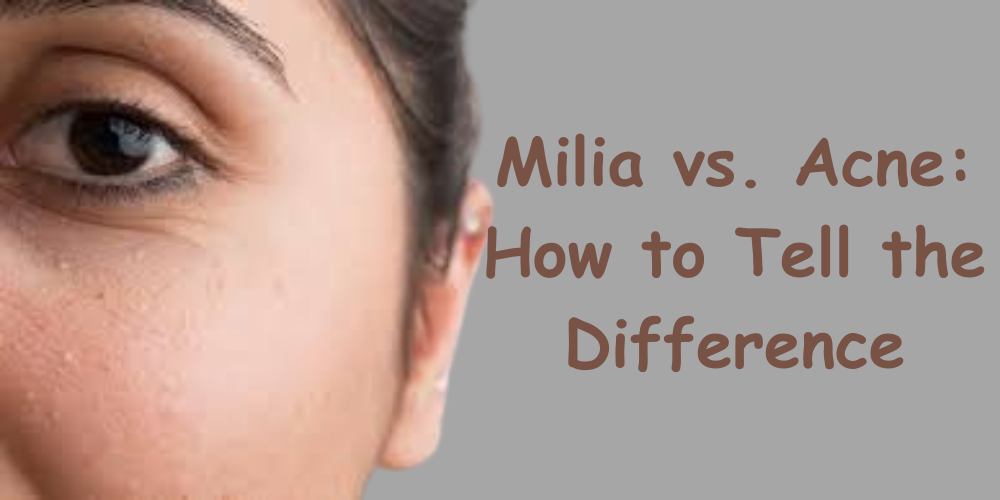
Definition and Aesthetics:
Milia:
- Milia are little cysts that form beneath the skin’s surface and are white or yellowish in color. They are usually 1-2 millimeters in length. milialar
- Milia, unlike acne, is firm to the touch and cannot be readily squeezed out.
- They are essentially keratin-filled cysts that form when dead skin cells become trapped beneath the skin. Miliaria
Acne:
- Acne is an inflammatory skin condition in which the hair follicles become blocked with oil, dead skin cells, and occasionally germs.
- Acne can appear as whiteheads, blackheads, pustules, nodules, or cysts, and the base may be red or inflammatory.
- In contrast to milia, some acne types (such as pustules) can be filled with pus and may explode when pressed.
Root Causes:
Milia:
- Dermabrasion and blistering injuries are examples of skin trauma.
- Sun damage over time
- The use of thick lotions or oils that clog skin pores
- Certain skin problems, such as blistering disorders
Acne:
- Excess oil is produced by overactive sebaceous glands.
- Dead skin cell buildup in hair follicles.
- Propionibacterium acnes, an acne-causing microbe, is present.
- Hormonal imbalances, particularly during adolescence and menstruation milialar
- Certain drugs and genetics
Management:
Milia:
- Often, no treatment is necessary because they resolve on their own. milialar
- Dermatologists may propose treatments such as microdermabrasion, topical retinoids, or small surgical procedures to remove persistent milia. milialar
Acne:
- Creams and gels available over the market that contain benzoyl peroxide or salicylic acid
- Oral antibiotics, birth control pills (for women), or topical retinoids are examples of prescription drugs.
- In extreme situations, light or laser therapy, as well as isotretinoin, may be used. milialar
- Large cysts may require chemical peels or drainage treatments.
Preventive measures:
Milia:
- Use light skincare products instead of hefty ones.
- Exfoliation should be incorporated into your skincare routine to eliminate dead skin cells milialar
Acne:
- Gently cleanse the skin, avoiding harsh scrubs.
- Makeup and skincare that are not comedogenic.
- Wash objects that come into contact with your face on a regular basis, such as pillowcases and cell phones. milialar
Miliaria Rashes Treatment Alternatives
Miliaria, often known as prickly heat or heat rash, is a common ailment caused by sweat duct obstruction. This obstruction inhibits sweat from reaching the skin’s surface, causing small, irritating bumps to develop. While the ailment is more common in hot, humid locations, it can affect anyone in the correct circumstances. Here’s a thorough guide to treating miliaria rashes:
1. Calm down: The first and most important step in treating miliaria is to get out of the heat and let your skin calm down. Stay in an air-conditioned room, or at the very least under a fan, if possible.
2. Loose Clothing: Wearing lightweight, loose-fitting clothing made of breathable fabric, such as cotton, will help to prevent further irritation and allow the skin to heal.
3. Avoid Sweating: Avoid activities that generate excessive sweating until the rash is gone. Excessive activity can aggravate the disease.
4. Topical Treatments: Calamine Lotion: Calamine lotion relieves itching and can help to settle the irritation.
Hydrocortisone Cream: This mild steroid cream, which is available over the counter, can relieve inflammation and itching. It should, however, be used sparingly and for short periods of time.
5. Chilly Baths: Taking chilly baths or showers might help relieve itchy skin. Instead of using harsh soaps, choose mild ones.
6. Avoid Oils and Heavy Creams: Thick creams and oils can further clog sweat ducts. Use light moisturizers instead.
7. Aloe Vera: Aloe vera’s inherent cooling action might help alleviate heat rashes. Aloe vera gel can be administered directly to the afflicted area.
8. Antihistamines: OTC antihistamines such as diphenhydramine (Benadryl) can help relieve itching, particularly at night.
9. Drink Plenty of Water: Drinking plenty of water helps regulate body temperature and minimizes the likelihood of excessive sweating.
10. oats Baths: To cold baths, finely ground oats (colloidal oatmeal) can be added. This provides relief to itchy and inflamed skin.
11. Seek Medical Attention: Seek medical attention if the rashes grow increasingly severe, exhibit signs of infection (such as pus), or do not resolve within a few days.
Dermatological Insights: Milia Formation Causes
Milia, often known as “milk spots” or “oil seeds,” are small, pearly-white pimples that can appear on the skin’s surface. Milia is a benign skin condition that is commonly observed on the face, particularly around the eyes, nose, and cheeks. While they may be unsightly to some, knowing their underlying causes is critical for prevention and effective treatment. milialar
- Natural Skin Renewal Process: The human skin goes through a constant renewal process in which old cells shed and are replaced by new ones. Milia can occur when the skin’s natural exfoliation process is disturbed, causing dead skin cells to become trapped beneath the skin’s surface. This keratin (a protein found in hair, nails, and skin) buildup eventually produces the small cysts known as milia. milialar
- Newborn Milia: Milia is notably common among newborns, with estimates indicating that more than half of all neonates will acquire milia. This is typically due to a newborn skin exfoliation mechanism that is undeveloped. Fortunately, infant milia usually resolve on their own within a few weeks.
- Cosmetic and Skincare Products: Certain cosmetic products, particularly those that are heavy or comedogenic (pore-clogging), can cause milia to occur. Rich creams and balms, as well as other items that retain dead skin cells and prevent them from naturally shedding, can contribute to their creation. milialar
- Skin Trauma: Any type of skin trauma, such as burns, blisters, rashes, or procedures such as dermabrasion or laser treatments, can result in the production of milia. The trauma can cause a disruption in the skin’s usual healing and shedding process, allowing milia to form.
- Genetics: There is some indication that milia can be passed down via generations. If you have a close family member who has had milia on a regular basis, you may be more likely to get it as well.
- Milia can also be connected with other skin conditions such as blistering disorders, porphyria cutanea tarda, or some kinds of epidermolysis bullosa.
- Sun harm: Prolonged sun exposure can harm the skin and limit its ability to exfoliate naturally. Sun-damaged skin can thicken and become less able to shed dead skin cells properly over time, resulting in milia production. milialar
Milia Prevention: Proactive Skincare Tips
Milia are little, white lumps that frequently occur on the face, especially around the eyes and cheeks. These little cysts can be unattractive and annoying to deal with, but with the appropriate skincare routine, you can prevent them. In this post, we’ll look at what milia is, why it forms, and provide you with some innovative and efficient skincare treatments to keep them at bay.eye milialar
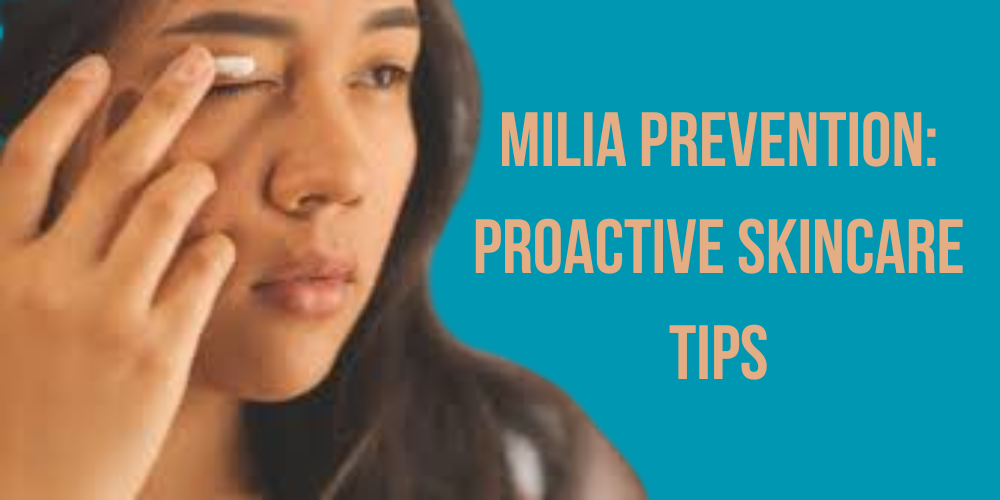
Recognizing Milia
Milia are sometimes confused with whiteheads or pimples, although they are not the same thing. These cysts form when dead skin cells become trapped beneath the skin’s surface, resulting in small, hard bumps. Milia, unlike acne, lacks an opening or pore to release the trapped material, making it more difficult to remove once it emerges.
Preventing Milia with Proactive Skincare
- Gentle Exfoliation: Exfoliation is essential for preventing milia. Instead of abrasive scrubs, use chemical exfoliants such as alpha hydroxy acids (AHAs) or beta hydroxy acids (BHAs). These substances aid in the dissolution of dead skin cells on the surface, lowering the possibility of them becoming trapped. milialar
- Use a Lightweight Moisturiser: Moisturisers that are too thick or greasy can contribute to the production of milia. Choose non-comedogenic, lightweight moisturizers that will not clog your pores. Look for goods that are labeled “oil-free” or “non-comedogenic” to ensure that they will not contribute to milia.
- Sun Protection: It is critical to protect your skin from the sun, Sun exposure might aggravate milia Wear a broad-spectrum sunscreen with at least SPF 30 every day, and when outside, wear a wide-brimmed hat and sunglasses. milialar
- Harsh cleansers should be avoided since they might strip your skin of its natural oils and upset its moisture balance. Instead, choose a soft, moisturizing cleanser that cleans without over-drying your face.
- Retinol Use on a Regular Basis: Retinol, a vitamin A derivative, can help prevent milia by stimulating skin cell turnover. To avoid irritation, begin with a lesser concentration and gradually increase it.
- Hydration from Within: It is critical for healthy skin to drink adequate water and stay hydrated. Your skin is less likely to trap dead skin cells when it is well-hydrated.
- Consult a Dermatologist: If you are prone to milia or have recurrent problems, see a dermatologist. They can extract milia safely and recommend customized skincare products and treatments. milialar
Milia Removal: Investigating Safe At-Home Techniques
Milia are little, pearly-white pimples on the skin that commonly develop around the eyes, nose, and cheeks. These little cysts are usually harmless, although they might be an aesthetic issue for some people. If you want to remove milia at home, it’s critical to prioritize safety to avoid consequences. In this post, we will look at safe at-home milia removal methods. milialar
Exfoliation and cleansing: It is critical to maintain appropriate skincare practices before attempting milia removal. Proper washing and exfoliation can help prevent the formation or aggravation of milia. To keep your skin clean and clear of dead skin cells, use a gentle cleanser and a moderate exfoliator. milialar
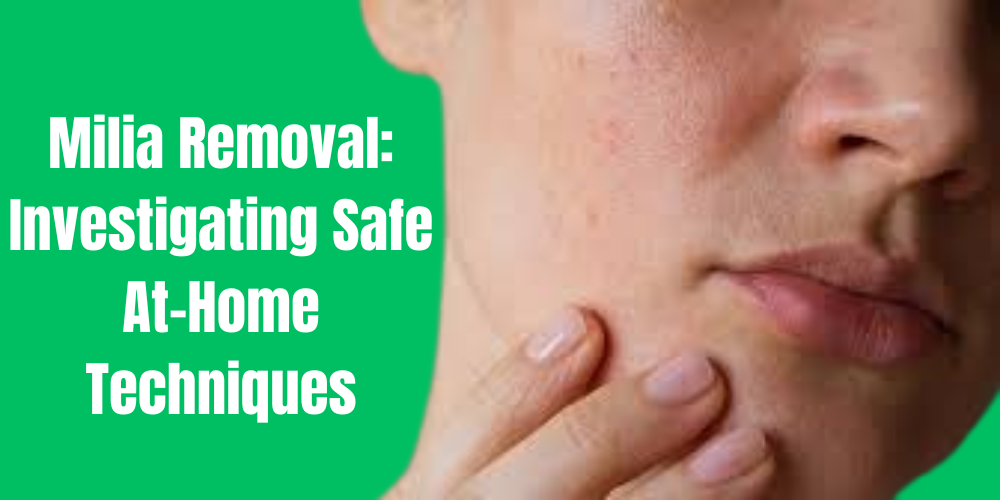
Hot Compress
A warm compress is one of the most effective and safest ways to treat milia at home. Here’s how to go about it:
- Begin by cleansing your face with a mild cleanser.
- Wring out a clean cloth after soaking it in warm (not hot) water.
- For 5-10 minutes, apply a warm towel to the affected region.
- Repeat this procedure every day to help soften the milia.
- Retinoids: Over-the-counter retinoid lotions containing chemicals such as retinol can be beneficial in the treatment of milia. These lotions can promote cell turnover and aid in the prevention of fresh milia development. They should, however, be used with caution and only as prescribed because they can be irritating to the skin.
- Do Not Squeeze: It is critical to avoid the desire to pinch or pick at milia. Popping milia can cause skin irritation, infection, and scars. Instead, choose safer measures such as warm compresses.
- Extraction by a Professional: If your milia persists or is creating severe cosmetic issues, you should see a dermatologist. They can safely retrieve the milia in a sterile environment using specialized instruments. milialar
Avoidance
Milia prevention is sometimes more doable than removing them. Follow these guidelines to lower the risk of milia formation:
- Use skincare that is non-comedogenic.
- Avoid using heavy, oily creams or cosmetics.
- Use sunscreen to protect your skin from the sun.
- Maintain a good skincare regimen.
Avoid DIY Extraction:
- While it may be tempting to try to pop milia on your own, this can result in infection and scarring. Leave extraction to the experts.
- Makeup Brushes Should Be Clean: If you wear makeup, make sure your brushes and applicators are clean. Dirty brushes can transfer bacteria and debris to your skin, potentially causing milia.
- Patience is essential: Remember that milia prevention takes time and constant work. Maintain your skincare routine and be patient.
The Relationship Between Sun Exposure and Milia Formation
Milia, often known as “milk spots,” are small, white, dome-shaped cysts that form on the skin, most commonly around the eyes, cheeks, nose, and brow. While they are largely cosmetic in nature, many people want to avoid or minimize their presence. Sun exposure is one element that is frequently connected to milia. Let’s look into the complicated interaction between sun exposure and milia production.
comprehension Milia
Milia form when keratin, a protein found naturally in the skin, becomes trapped beneath its surface. These are not to be confused with acne pimples or whiteheads. They are instead little cysts that are firm to the touch and do not inflame or pain.
The Role of the Sun in Skin Processes
The sun is important in a variety of skin functions. It aids the body’s production of vitamin D and can affect the texture, tone, and suppleness of the skin. Excessive sun exposure, on the other hand, can be harmful to the skin.
Sun Damage and Skin Thickness
Prolonged sun exposure can cause skin damage, including accelerated aging, decreased suppleness, and thicker skin. This thickening serves as a defense mechanism, but it also makes it more difficult for dead skin cells to slough off naturally. These dead skin cells might contribute to the production of milia when they aggregate.
Collagen Degradation
UV rays degrade collagen and elastin fibers in the skin over time. Collagen maintains our skin tight and youthful, and when it depletes, our skin becomes more prone to a variety of problems, including the formation of milia.
Sunscreen Is a Two-Edged Sword
While it is critical to use sunscreen to protect our skin from dangerous UV rays, certain sunscreens contain heavy oils and chemicals that can block pores, contributing to milia production. It is critical to use non-comedogenic sunscreens, especially on the face.
Avoiding Milia Formation
To reduce the chance of acquiring milia as a result of sun exposure:
- Limit direct sun exposure, especially between 10 a.m. and 4 p.m.
- Sunscreen: Use a broad-spectrum sunscreen with an SPF of 30 or higher. Check that they are not comedogenic.
- Protective clothing, such as wide-brimmed hats, sunglasses, and long-sleeved shirts, should be used.
- Exfoliation on a regular basis can help eliminate dead skin cells and lower the likelihood of milialar formation.
Milia Lifespan: How Long Do They Last?
Milia are tiny white or yellowish cysts that can form on people of all ages’ skin. These tiny, raised lumps are sometimes confused with pimples or whiteheads, but they are distinct in appearance and cause. Understanding the lifespan of milia is important for persons who are concerned about their appearance.
What exactly is milialar?
Milia are small cysts filled with keratin, a protein found in the skin, hair, and nails. They can occur when dead skin cells become trapped beneath the skin’s surface rather than sloughing off naturally.
Milia Common Locations
Milia can appear everywhere on the body, but it is most usually found on the face, particularly around the eyes, cheeks, and nose. Milia, sometimes known as “baby acne,” can affect newborns, but the two conditions are not the same.
Milia’s Lifespan
Acne pimples do not have the same lifecycle as milia. Milia will typically:
- Milia in newborns usually resolves on its own within a few weeks.
- Primary Milia in Children and Adults: This type of milia might take weeks to months to resolve. They can last longer in some cases if left untreated.
- Secondary milialar: These develop after a skin injury or trauma, such as a blister or poison ivy rash. The lifespan varies, but it frequently corresponds to that of primary milia.
Treatment Alternatives
While milia can resolve on its own, some people prefer to use therapies to hasten the process or to treat persistent milia. Among these treatments are:
- Topical Retinoids: These can help enhance skin cell turnover, which can help avoid the formation of milia and speed up the resolution of existing ones.
- A dermatologist can use a chemical solution to remove the top layers of skin, facilitating faster skin cell turnover.
- Extraction: Milia can be carefully extracted by a dermatologist using a sterile needle.
- Microdermabrasion: This process removes the top layer of skin, which can aid in the treatment of milia.
Security
To reduce the likelihood of developing milia:
- Maintain a regular skincare routine to keep your skin clean and moisturized.
- Exfoliate on a regular basis to eliminate dead skin cells, but avoid exfoliating excessively as this might irritate the skin.
- To avoid congested pores, use non-comedogenic products.
Conclusion
While milia are usually harmless and cures on their own, they can be a cosmetic concern for many people. One can manage and possibly avoid their occurrence by studying their lifecycle and implementing a healthy skincare routine. If the milialar persists or causes worry, it is always better to see a dermatologist.
FAQ: milialar
What is the cause of milialar Dermatitis?
The primary cause of this ailment is clogged sweat ducts. When perspiration cannot reach the skin’s surface, it becomes trapped behind the epidermis, causing discomfort and rash.
What are the signs and symptoms of heat rash?
Among the symptoms are:
Skin irritation in the form of little red bumps.
Itching or prickling sensation in the affected area.
Swelling that is not severe.
Who is susceptible to heat rash?
While anybody can acquire heat rash, it is more frequent in babies, those who live in hot, humid areas, and people who participate in strenuous physical activity.
What is the treatment for milialar Dermatitis?
The majority of cases of heat rash will go away on their own. Among the suggestions are:
Maintaining skin cool and dry
Keeping away from severe heat and humidity
Wearing clothing that is light and breathable
Topical therapies such as calamine lotion or hydrocortisone cream may be used in more severe cases.
Can heat rash be avoided?
Yes, here are some precautions to take:
If you get too sweaty, take a shower and properly dry off.
In warmer weather, dress in light, loose-fitting clothing.
During peak heat, stay in air-conditioned areas.
When it’s really hot and humid, avoid excessive exertion.
When should I go to the doctor?
If the rash does not improve after a few days, grows more severe, exhibits signs of infection such as pus or increased redness, or if you have fever or chills, seek medical assistance immediately.
